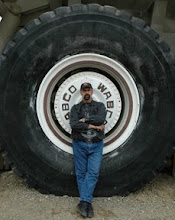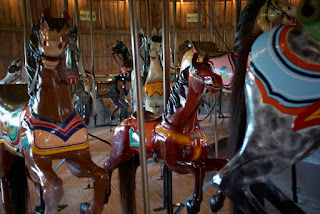And yet again I have had an opportunity to visit a piece of
art. This one is located in a small town in Ontario called Roseneath. It’s
another C.W. Parker carousel and it is an early one (actually the number 3 is
stamped on the ring gear). It was built in Abilene Kansas in 1906 (before
Parker moved the facility to Levenworth in 1911).
The carousel is only open on Sundays for a 3 hour period in
the afternoons (until their fall fair in October when it will be open longer).
I spent the weekend at my brother Ralph’s place and on the Sunday we headed out
early in order to see if we could locate the carousel, he operating as official
navigator for the trip.
There were no signs to point the way (a fact that I’m
somewhat mystified by since this carousel is worth on the order of a million
dollars) but we managed to find the site and the barn in which it is housed. We
were, in fact, a couple of hours early for it to be opened and so we spent the
time in and around the town talking to people and generally being tourists
(which is another story that I might go into at another time).
When the sixteen-sided building was finally opened for
business my brother and I made our way over to the entrance and entered the
enchanted realm.
This is a carousel built in the ‘Country’ style, or ‘County
Fair’ style if you will. It is slightly smaller than some of the bigger ones
(which means, probably, that is was meant to be taken apart and moved with the
circuit of a traveling carnivals). It has a much happier group or herd of
horses; the horses don’t have that same panicked look that I’ve seen on other
carousels and horses. Many of them seem to smile at you.
There are 40 hand carved basswood horses, 3 abreast, and for
some reason there are 2 boats (which also rock) as part of the grouping.
It travels at a whopping 4 ½ miles per hour, although it
seems faster than that. I don’t know where you clock the speed of the carousel,
whether from the inside row of the deck near the gearing or from the outside
edge because it does make a difference on how apparently fast the horses are
going.
In addition there is a slightly different mechanism in place
for the jumpers, which gives it more of a forward and back ride rather than
just the up and down movement. It’s meant to more closely emulate the movement
of a horse. You can see it, if you look closely, in some of the photographs here.
The middle row of horses, somewhat smaller than the others,
were carved by a gentleman named Hershell who for a time was an assistant of
Parker, so they are often referred to as Hershell/Spillman horses or
Armitage/Hershell horses.
In the time that we were there it was interesting, in
retrospect, that there were no children around, well except for those children
of my age bracket, who had come to see, to appreciate, and to photograph the
carousel. It was a pleasure to see the smiles of the big people as they rode
the ride.
Another cool aspect of this expedition is that the people who operated it allowed us to climb over the ride, they even let me into the centre ring (when the carousel was not whirling) so that we could take photographs.
The music that played while the ride was in operation was a
delight. They have several rolls of music that are played on a 1934 Wurlitzer
Military Band organ (itself worth $300,000.00), another aspect of the charm of
the day.
They are looking for funding to help with the ongoing
restoration work and to build a new climate controlled building for it to be
housed in. Ralph and I spent some money on the goods available to purchase (I
finally bought myself a carved carousel horse, in miniature, and at what I
thought was an excellent price, so that I could finally claim one for my own).
And I would also like to give a special thank you to my friend Lorie who told me about it.
All photographs here are by me. I hope you like the black and white shots as well, they add a certain nostalgia to the scene, and black and white photography, like carousels themselves, are sort of a dying art.

















No comments:
Post a Comment